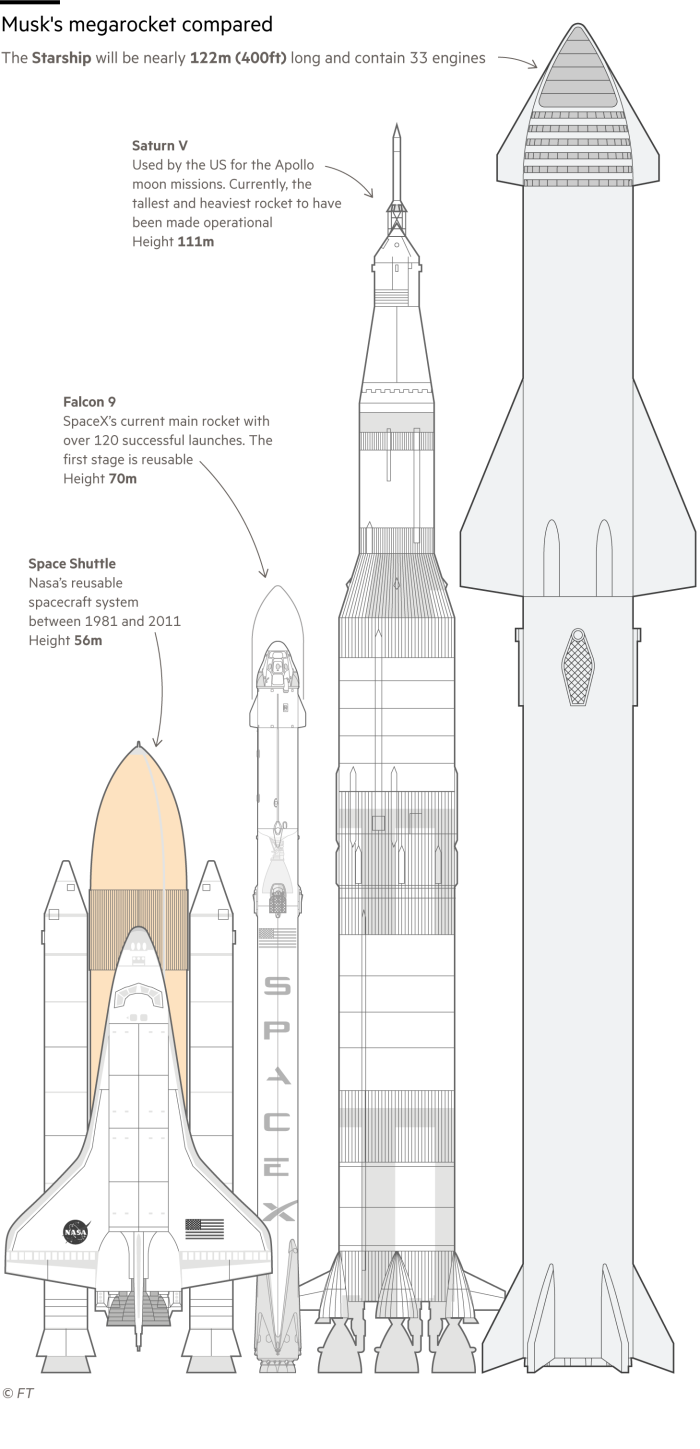SpaceX: how Elon Musk’s new rocket could transform the space race
At the southernmost tip of Texas, alongside the Gulf of Mexico, a gleaming stainless steel rocket has been rising from the salt marshes.
At nearly 400ft, the new SpaceX rocket will eventually be taller than the Saturn V that carried Nasa’s Apollo missions to the moon, and its 33 engines will deliver twice the thrust. For Elon Musk, SpaceX’s founder, it is meant to play a key role in one day establishing a human colony on Mars.
But the rocket, dubbed the Starship, could have a far more immediate impact on a space industry that has already been shaken by Musk’s ambitions. With the power to carry as much as 100 tons into low orbit around the Earth, his admirers claim Musk is about to transform the economics of the launch business.
“It’s game over for the existing launch companies,” says Peter Diamandis, a US space entrepreneur. “There’s no vehicle out there on the drawing board that could compete.”
Musk’s space company still has some way to go to live up to the promise, including winning regulatory clearance to launch Starship from its Texas site and showing that it can reliably reach space while returning both the rocket’s stages for reuse — an essential step in reducing launch costs.
Also, many experts question whether a large rocket designed to colonise another planet can double up as an all-purpose transport for more varied and mundane tasks closer to Earth. But SpaceX’s success in turning its current rocket, the Falcon 9, into the main workhorse for reaching space has made others in the commercial space industry nervous.

“If you’re not careful, SpaceX will be the only game in town,” says Fatih Ozmen, co-founder of Sierra Nevada Corp, a private US company that has been contracted by Nasa to fly cargo to the International Space Station. Blue Origin, Jeff Bezos’ private space company, makes a blunter claim: SpaceX could end up with “monopolistic control” of US deep space exploration.
Musk’s venture has put itself in a commanding position in the new commercial space industry with surprising speed. It is only 13 years since it became the first private company to launch its own rocket into orbit, breaking into an industry previously dominated by nation states. It has also leapt ahead of contractors such as Boeing and Lockheed Martin, whose joint venture, United Launch Alliance, had carried the flag for US space launch — though using Russian engines.
SpaceX’s ascendancy has been underlined over the past six months by a striking series of wins.
They include a $2.9bn contract awarded by Nasa to use the Starship to land its astronauts on the moon as early as 2024. It was the space agency’s decision to pick only one supplier for this programme, after earlier indicating it would select two, that brought the warning from Blue Origin. Nasa officials point out that they have only awarded SpaceX a single mission, leaving them open to choose other suppliers for future landings. But Blue Origin claims that adapting its systems to work with the Starship will force design changes that will lock the agency into a dependence on SpaceX in the long term.

Read More: SpaceX: how Elon Musk’s new rocket could transform the space race
